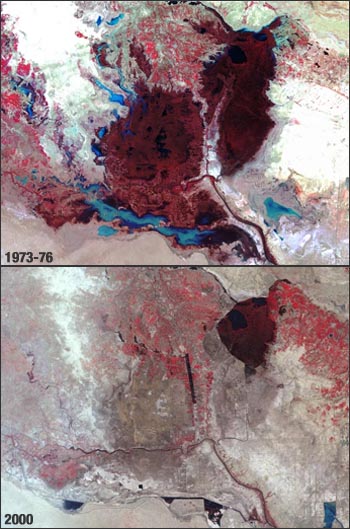Contributor: Jeff Masek

The United Nations Environmental Programme (UNEP) has undertaken an assessment of the recent dramatic decline in some unique Mesopotamian marshes, and has relied heavily on Landsat data for their mapping. The Mesopotamian marshes once extended across 15,000 – 20,000 square kilometers. They are the homeland for the “Marsh Arabs”, Shi’ite Muslims who have evolved a subsistence economy based on hunting and fishing within the marsh area. Ecologically, these wetlands provide an important breeding and wintering habitat for migratory birds.
Beginning in the 1950’s, 32 large dams were constructed upstream on the Tigris and Euphrates tributaries in Turkey, Iran, Syria, and Iraq. Although these dams provide water for irrigation and hydroelectric power, they also have had the effect of diminishing the supply of fresh water to Mesopotamian marshes downstream. In addition to the reduction in water volume, much of the runoff from irrigation projects is heavily saline, contaminating the marsh ecosystems. As a result of water diversion, the Mesopotamian marshes have begun to desiccate and shrink. This trend was accelerated by the policies of the Iraqi government in the 1990’s which set out to purposely drain the marshes, partly in response to civil opposition by the Marsh Arabs.
Using Landsat imagery from the 1970’s and 2000, the UNEP team concluded that some 86 percent of the marshland had already been lost, mostly since the Gulf War in 1991. At that rate of loss, the marshlands could have disappeared entirely within the five years. However, the fall of Iraqi leader Saddam Hussein lead to the removal of the the dykes and barriers that were starving the marshes for water. Today, the marshes are once again being reflooded by regional rivers.
Related Earth Observatory stories:
Annual Floods Return to Iraq
Vanishing Marshes of Mesopotamia

Scenes from the Polar Night
Landsat satellites have begun regularly acquiring images of ice at the poles during the winter, with enlightening results.





